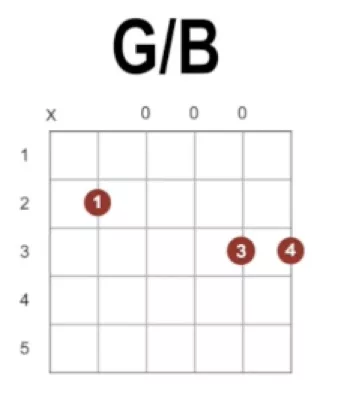Start Using Slash Chords
So many great easy guitar songs use slash chords to create smooth and melodic bass lines that go down or up one step at a time as the chord changes. You might have seen these slash chords on a guitar chord chart and not have been sure about what to play!
First, what are slash chords? A slash chord is just a guitar chord with a note other than the root note as the lowest note or bass note. When it’s written out in a chart, that means that there is a specific bass line happening, where the bass note is not the root note, as it more typically is.
Here is what a slash chord looks like written out:

The first letter (G) indicates that the chord is a G chord. The second letter (B) indicates that the lowest note of the chord should be a B. In this case, the B is already part of the G chord. The three notes of a G chord are G(root),B(third) and D(fifth). So the B is the third of this chord.
Here is an example of a chord progression that uses slash chords to create a descending bass line:

The ones that you will see over and over again on chord charts are G/B and D/F# as shown in this graphic. The G/B will often connect a C and an A minor chord. The D/F# will often connect a G and an E minor chord.
There are also some common variations of a C major chord like C over G, where you add the third fret of the low E string, and C/E, where you add the open low E string.
Slash chords are a great way to create new colors in your normal open chords. It’s a simple technique that opens up your ability to play more advanced songs, or even write some new chord progressions yourself!
Gary Heimbauer is a writer for Guitar Tricks and 30 Day Singer.
